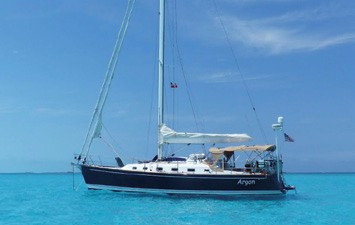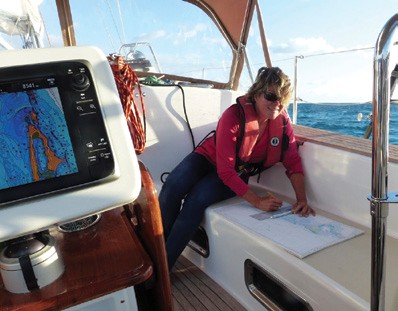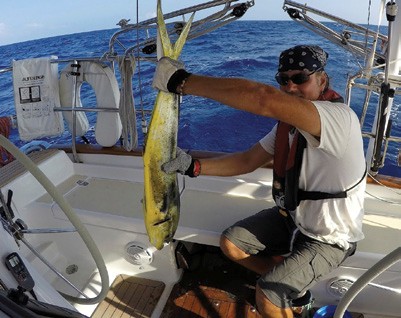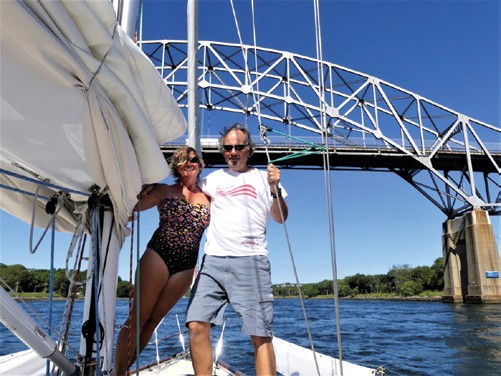Finances, Fuel, Feuds and Fishing
By Captain Linda Perry Riera
Editor’s note: This is the fifth installment in a series of dispatches from Linda and Captain Bob Damiano, who recently completed the island portion of a 10-month sailing voyage aboard their Tartan 4000 and are now back in New England waters.
 Ten months, 5,000 nautical miles, 15 countries, 80 harbors. One broken collarbone, one clogged head, and one seized up water pump. Hundreds of cruising friends met. This trip has been an unbelievable adventure in so many ways. Below are some more data and figures of our extended cruise.
Ten months, 5,000 nautical miles, 15 countries, 80 harbors. One broken collarbone, one clogged head, and one seized up water pump. Hundreds of cruising friends met. This trip has been an unbelievable adventure in so many ways. Below are some more data and figures of our extended cruise.
Although $68,000 sounds like a lot, this was our total expenditure for 10 months of living…Intense living filled with unique adventure, travel, challenge and beauty. It was worth every penny. © ArgonSailing.com
Many wonder, few ask: How much does a trip like this cost?
There is a range of how to approach an extended cruise from a lifestyle and thus financial perspective, and scant specific information out there. During our planning phase I would read Beth Leonard’s The Voyagers Handbook in the evenings (while sprawling on my king-sized bed…Ooohh, to sleep on a big bed again; I digress). Beth’s book is a wonderful resource for learning about passage planning, watch keeping, anchoring, sail handling, living aboard, etc. A particularly interesting section is devoted to finances and is highly recommended for anyone considering an extended cruise. Below is an estimation of our monthly and total spend.
Monthly cruising expenses
Groceries & staples $650
Eating out $1,100
Fuel $90
On land transportation (rental cars, cabs, bike rentals) $80
Customs & immigration fees (variable) $180
Docking & moorings $300
Laundry $40
Connectivity & local data $300
Boat parts & charts $300
Miscellaneous clothes & stuff $200
Activities (including tours) $200
Weather routing for offshore passages $120
Boat insurance, documentation & taxes $600
Total monthly cruising spend rate $4,160
Non-cruising expenses
Medical insurance $900
Storage unit $220
Cell phone $300
Total non-cruising monthly spend rate $1,420
Total monthly spend (cruising & non-cruising) $5,580
Total for 10 months (cruising & non-cruising) $55,800
Ad hoc hits (10-month totals; not monthly
Broken collarbone (most definitely out-of-network) $1,600
Travel visits with kids $7,000
Travel home to Boston (Bob once, Linda twice) $2,000
Crew expenses for long offshore passages $1,800
Total ad hoc spend $12,400
Total cost for 10 months (exclusive of pre-trip preps) $68,200
Disclaimer: We started off with an extremely ready, seaworthy vessel (and lots of up front investment into it). Many cruisers we met along the way had older vessels and needed to spend more time and money fixing things along the way.
 Our monthly burn rate was a bit higher than we initially forecasted, mainly driven by:
Our monthly burn rate was a bit higher than we initially forecasted, mainly driven by:
Data/connectivity Our (aka Bob’s) need for data due to his job is definitely much more than that of the average cruiser. And we have accumulated half a terabyte of photos and videos to upload.
We logged 5,000 nautical miles on our 10-month voyage.© ArgonSailing.com
Eating out One can certainly spend less by cooking aboard vs. eating out as much as we did, but we enjoy experiencing the islands by visiting lots of different restaurants and eateries.
Trips The visits with the boys were fantastic, and I am very grateful for the special time with them in gorgeous locations. In hindsight, we would have chosen less expensive locales. Two of the three countries we selected for visits, Bermuda and Turks & Caicos, were extremely expensive.
Docking more than planned (vs. anchoring which is free) Dock fees varied widely, from $40 to $160 per night. (The lower priced docks were only basic tie-ups with no electricity or water.) Sometimes we docked to be more secure in high winds, or to be able to get shore power to run the air conditioner a bit (to dry out the boat more than to cool it), and to give Argon an occasional good exterior washing. We extended dock time in St. Maarten to give Bob’s collarbone some time to heal and in Turks & Caicos due to bad weather and waiting for boat parts.
Some added notes about spending
Boat insurance Many cruisers deem this optional or too expensive, and opt out. Some marinas require insurance for dockage. I suspect shipyards will also require it if a haulout is needed. Our insurance premium was quite high due to our scant offshore experience prior to the trip and the associated dangers with the long offshore passages (and shorthanded crew). In the future, our premiums should be less as our experience is now much more robust.
Medical insurance Many cruisers are a bit older than we are and seem to have medical insurance either through their retirement package and/or Medicare (if they’re from the U.S.) or national insurance, of course, if from outside the U.S. We both purchased private, basic policies through the healthcare exchange last year and planned to mostly pay out of pocket for minor needs.
Income
Bob continued working remotely throughout the trip (more than planned at about 20 to 30 hours per week), which helped address the ad hoc hits and lessen the savings drain.
I had put aside $40,000 from my savings prior to the trip. This is gone; time for me to get back to work, I guess. (I left my job in July 2016.)
YouTube sailing channel and ad revenue from blog: Well, we are not popular enough to make more than a couple of dollars a month here…yet.
Cost of Cruising vs. Cost of Living on Land
This is a discussion Bob and I have had several times when we estimate the cost of this trip. The above representation does not compare to the expenses of living on land in a house and weekend boating expenses to the cost of living aboard and setting off on an extended cruise. Many of the expenses above would have been incurred even if we had not been cruising (groceries, eating out, boat parts, cell phones as well as many of the boat-related expenses). In addition, we have not been spending money for a year or more on the following:
- Personal cars and associated insurance, maintenance, gas, repairs
- Home mortgage, taxes, insurance, maintenance and repairs
- Accumulating stuff to fill and replenish home
- Summer dockage, haulout and winter storage
I guess one might be able to rationalize that we saved money on this trip. 🙂
Fuel
There are a few reasons why most long distance cruisers are in sailboats, not powerboats: (1) sea steadiness/handling in big waters; (2) cost of fuel; and (3) travel distance with available fuel. We strive to sail as much as possible, but firing up the diesel is necessary when winds have died as well as for motoring into and out of harbors. In addition, the alternator on the diesel engine will charge our batteries when the solar panels can not keep up, such as when we were in higher latitudes (last fall) and when there were extended periods of overcast. We consumed 270 gallons of diesel overall.
We track our diesel fuel consumption rate to ensure we know our range on a tank of fuel. At 0.8 gallon per hour, we can run the engine for 96 hours. Depending on conditions, this would yield a range of about 675 nautical miles. This is important to know for extended offshore trips, should the need to motor rise substantially.
Our most efficient trip may have been from Hampton, VA to Bermuda (650 nautical miles) using only about 0.6 gallons diesel, which translates to 2,247 miles per gallon (I’m feeling very green). However, total gallons consumed these past ten months were 270, which for a 5,000-nautical mile trip translates to 21 miles per gallon. Diesel prices ranged from a high of $7.91 per gallon in Antigua to lows around $2.60 in North Carolina. Our total spend was about $850 on diesel and about $50 on gasoline for the dinghy. Other than renting a car a few times, we had no automobile expenses this past year.
Feuds and Fights
Bob = Introvert, Mr. Fix-It, keen attention to detail and safety, anxiety prone
Linda = Extrovert, big picture, optimistic, not anxious enough
Both = Love sailing, Argon, and each other
As friends have commented, Bob and I most definitely find our chi best when sailing. However, there have been a few times during this trip when we butted heads and both wanted nothing more than to get away from each other. Two of these times, we were kind of stuck on the boat and I was unable to easily stomp off and away. Argon feels very tiny at times.
Fishing
 © ArgonSailing.com
© ArgonSailing.com
Our early fishing success was attributed to Smitty, our third crew person for the six-day Bermuda to Antigua passage. This would be followed by a couple of months of being skunked before starting to get hits and bring in mahi, wahoo and barracuda, starting around the waters of Puerto Rico, Turks & Caicos, and throughout the Bahamas. It is customary not to eat barracuda in particular as they can be infected with ciguatera, so we carefully plied out the lure and threw these mean guys back.
Another Project Management Spreadsheet
We lived by a multi-tab spreadsheet the 18 or so months prior to our trip, to help us organize the many things to do, to buy and to learn. Now we have started a new log of projects to tackle this winter, complete with cost estimates, due dates, and completion statuses. Below are a few items on the list.
Upgrades Reacher fairlead car adjusters; rope clutch replacement (started recently in Mystic); add solar panel (Solbian 50W) and controller – this will increase our (theoretical) power generation from 335 to 385; DC to AC converter; aft cabin shelves; nav station instrument; top down furler for spinnaker (not sure); ground tackle (increase from 100 to 150 feet of chain); compass light re-wiring to separate breaker, etc.
Maintenance and replacements Sails (main, jib and genoa) washed, inspected and repaired; canvas cleaned and treated; new sail cover; brightwork (teak cap rails, cockpit table, dorade box covers, etc.) and interior floor varnishing; dinghy outboard engine servicing; dinghy cleaning and proactive patching; galley faucet (done); head hoses (yuk); move stern light; gooseneck inspection and new bolts, etc.
 But wait, it’s only September! We have the rest of the season to spend enjoying the New England waters, so not to much attention to this spreadsheet just yet!
But wait, it’s only September! We have the rest of the season to spend enjoying the New England waters, so not to much attention to this spreadsheet just yet!
Entering the Cape Cod Canal on the lest leg of the journey home © ArgonSailing.com
Captain Linda Perry Riera and Captain Bob Damiano are the owners and operators of All Hands Sailing Charters, LLC in Boston, MA (allhandssailing.com). You can follow Linda and Bob’s journey (and view their very well produced videos) at ArgonSailing.com.




